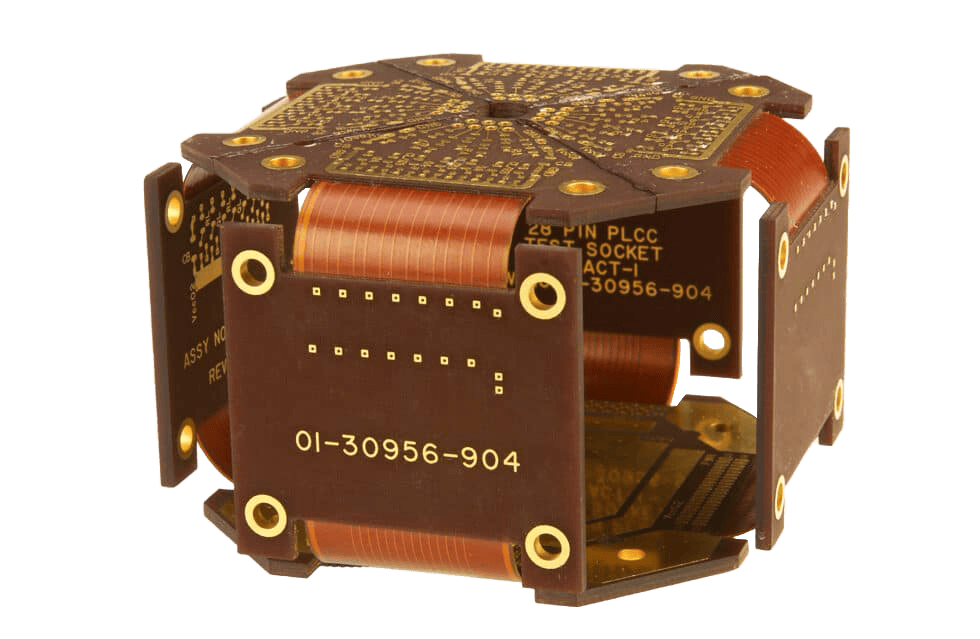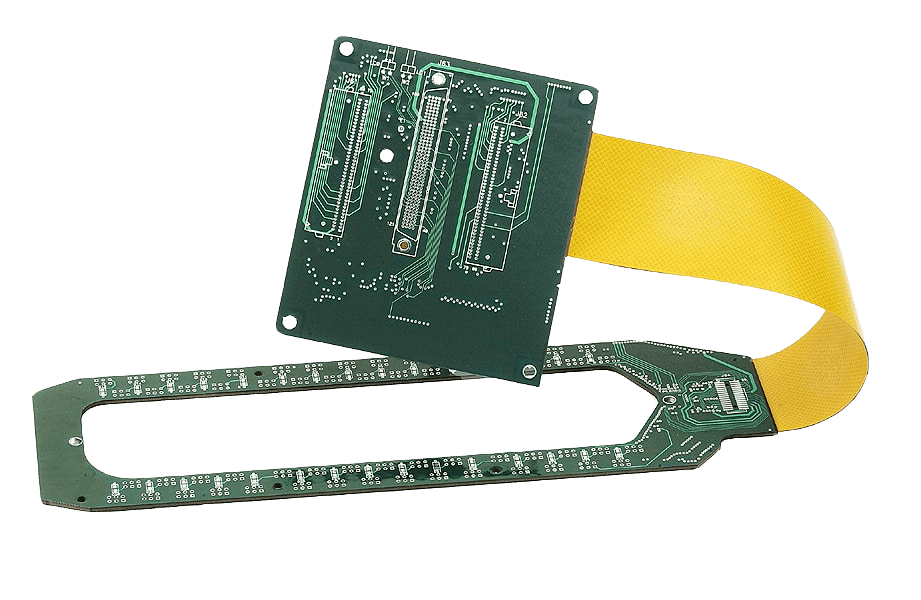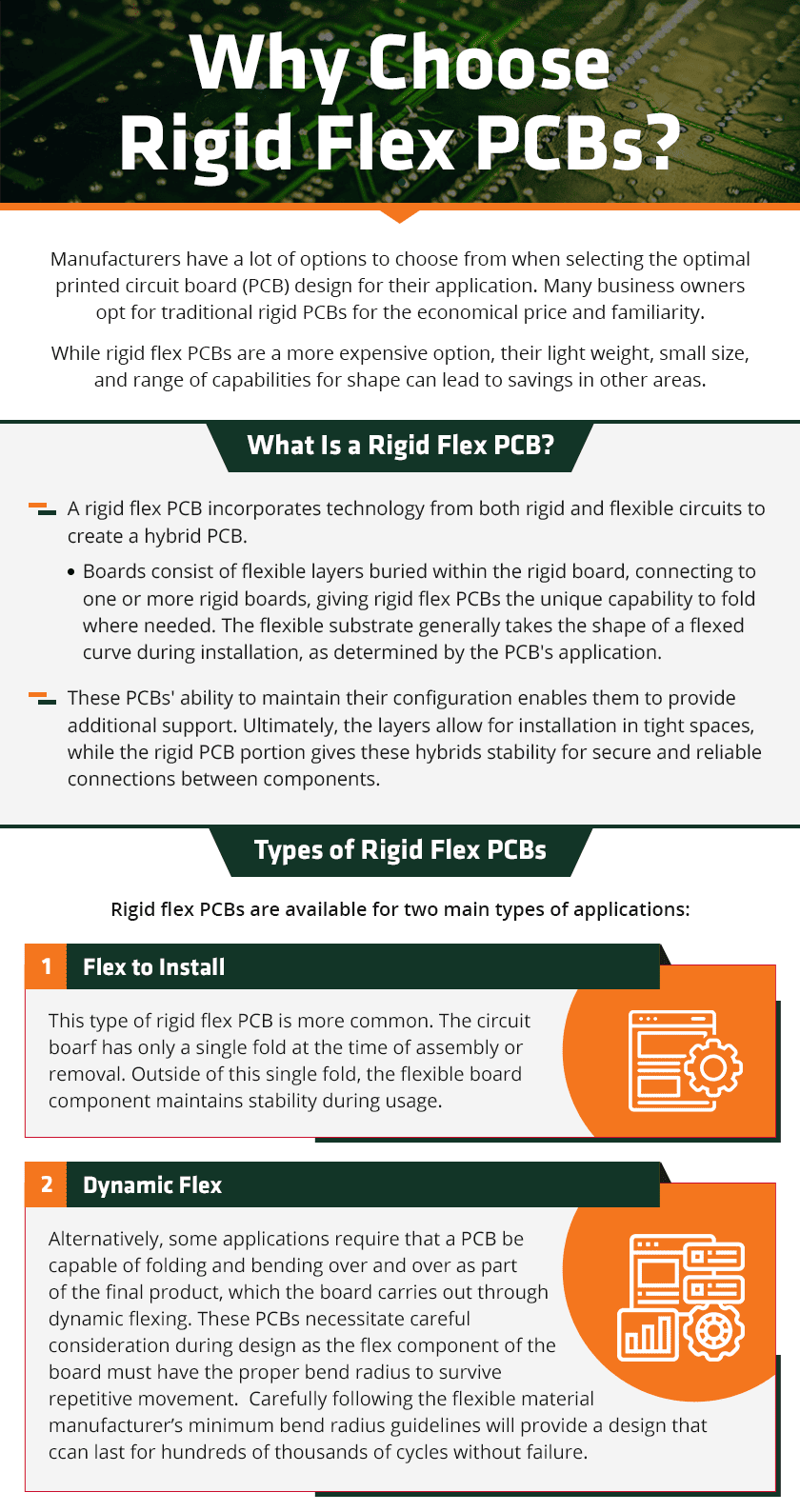Why Choose Rigid Flex PCBs
What is a Rigid Flex PCB?
A rigid flex PCB incorporates technology from both rigid and flexible circuits to create a hybrid PCB. These multilayered boards consist of flexible layers buried within the rigid board, connecting to one or more rigid boards, giving rigid flex PCBs the unique capability to fold where needed. The flexible substrate generally takes the shape of a flexed curve during installation, as determined by the PCB’s application. These PCBs’ ability to maintain their configuration enables them to provide additional support. Ultimately, the layers allow for installation in tight spaces, while the rigid PCB portion gives these hybrids stability for secure and reliable connections between components.

Types of Rigid Flex PCBs
Rigid flex PCBs are available for two main types of applications:
Flex to install.
This type of rigid flex PCB is more common. The circuit board has only a single fold at the time of assembly or removal. Outside of this single fold, the flexible board component maintains stability during usage.
Dynamic flex.
Alternatively, some applications require that a PCB be capable of folding and bending over and over as part of the final product, which the board carries out through dynamic flexing. These PCBs necessitate careful consideration during design as the flex component of the board must have the proper bend radius to survive repetitive movement. Carefully following the flexible material manufacturer’s minimum bend radius guidelines will provide a design that can last for hundreds of thousands of cycles without failure.
Applications and Advantages of Rigid Flex PCBs
Though rigid flex boards cost more, they are supremely versatile, with customization capabilities that enable a broad spectrum of industries to make use of them. These PCBs are ideal for aerospace, military, and healthcare devices, and they have additional applications in various commercial and industrial applications.
In some situations, rigid flex PCBs can actually be the more economical option. Rigid flex circuit assemblies minimize or even eliminate the need for connectors, as well as the labor, yield, transmission, and reliability issues that are inherent in their application. Assemblies connecting four or more rigid boards can often be built more economically with a rigid flex design. Any assembly that can benefit from these features can benefit from a rigid flexible PCB, as their versatility allows for numerous rigid flex PCB applications.

Slim Profile for Thin Packaging Applications
The thin configuration of a rigid flex PCB is another primary advantage, because, with a standard dielectric of 0.001" to 0.002" in flexible circuits, it is ideal for very thin and lightweight packaging. The smaller size can also eliminate the need for additional connectors, allowing the end product to be free from a "circuitry first" design focus. Rigid flex PCBs allow end products to be smaller. This provides some cost advantages and is a more consumer-friendly option for handheld devices.
Subheader
Reliability in Applications Requiring Precision
Rigid flex PCBs are preferable when precision and reliability are paramount to budgetary considerations, such as when failing connectors or cables could lead to hazardous situations. When compared to traditional rigid PCBs, durable rigid flex circuit boards offer inherent reliability due to the elimination of many points of interconnectivity, which cuts down on the risk of circuitry failure.
Subheader
Rigid Flex Survivability in High-Shock, High-Vibration Applications
Rigid flex PCBs can withstand high levels of stress because they are capable of superior resistance to shock, even in the presence of environmental conditions that would result in part failure in other PCBs. However, these PCBs tolerate much more than just shock and vibration. Rigid flex PCBs also hold up well in the face of UV light, chemicals, oils, and radiation exposure, and have high levels of heat dissipation.
Subheader
Space Economy to Solve Density Issues
Some high-density assemblies do not have the necessary surface area to accommodate the cables and connections an application requires for functionality, and in these cases, rigid flex circuitry can solve this issue by economizing space. Five or more connected boards (such as multilayer rigid boards) can crowd an assembly and decrease spatial efficiency, so replacing multiple boards with an individual rigid flex PCB may be an optimal, and even a more cost-effective, way to go. The reduced need for connectors and cables frees up space in the design of the end product for device miniaturization. Rigid flex PCBs are much more practical when trying to maximize limited space in an installation as the flex portion of rigid flex PCBs can offer up to 180° of full bendability.
SubheaderMultilayer Rigid Flex PCB
Multilayer PCBs can be any type of PCB, including rigid or rigid flex, with multiple copper layers. Any board that has at least three conductive layers falls under this category. These boards are designed in a sandwich fashion, with several double-sided conductive layers separated by an equal number of bonding sheets called prepreg.
Multilayer PCBs are commonly found in devices that include complex circuitry. This includes computers, laptops, tablets, smartphones, GPS trackers, and countless other products. When rigid flex PCBs are used, the result is a multilayer rigid-flexible PCB. The interior layers join selectively, and the use of multiple layers becomes necessary for applications that need to achieve additional routing density for their application.
Rigid Flex PCB Design Capabilities
With the interconnectivity of the flex components and hardboards, manufacturers of multilayer PCBs have greater flexibility of design in their rigid flex PCB stackups. Designers can shape these PCBs into three-dimensional configurations, bending and folding as needed.
Designers can enhance both readability and operational performance by replacing multiple rigid PCBs and connectors with a single unit. Additionally, the end product can be smaller, lighter, and less bulky, as connectors and flexible interconnects are not necessary. The simplicity of a rigid flex multilayer PCB will also simplify the assembly process for increased production and installation speeds.
Rigid Flex PCB Circuitry for Quality Performance
When choosing between traditional rigid or rigid flex PCB circuitry, consider the application. Rigid flex PCBs imbue products with reliable strength, and their lightweight, compact configurations provide optimal performance and design versatility. Their capacity for customization makes them an ideal option for diverse applications.



